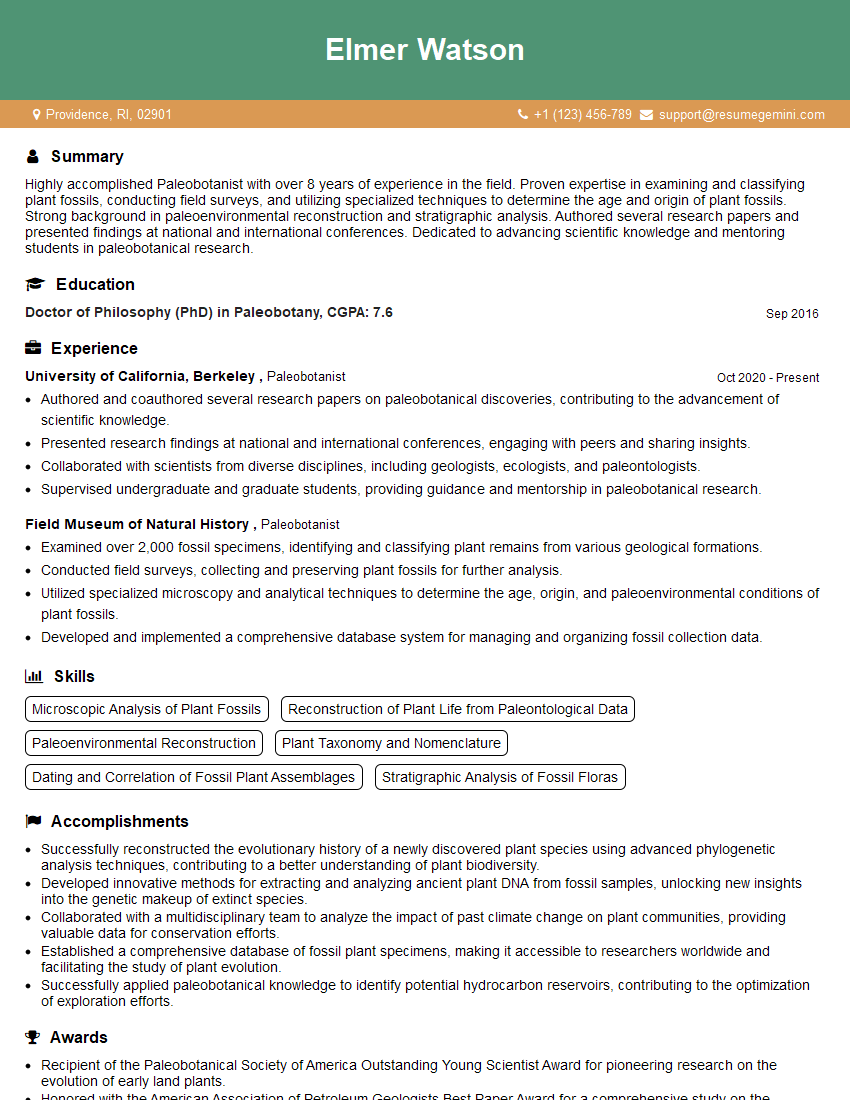Are you a seasoned Paleobotanist seeking a new career path? Discover our professionally built Paleobotanist Resume Template. This time-saving tool provides a solid foundation for your job search. Simply click “Edit Resume” to customize it with your unique experiences and achievements. Customize fonts and colors to match your personal style and increase your chances of landing your dream job. Explore more Resume Templates for additional options.

Elmer Watson
Paleobotanist
Summary
Highly accomplished Paleobotanist with over 8 years of experience in the field. Proven expertise in examining and classifying plant fossils, conducting field surveys, and utilizing specialized techniques to determine the age and origin of plant fossils. Strong background in paleoenvironmental reconstruction and stratigraphic analysis. Authored several research papers and presented findings at national and international conferences. Dedicated to advancing scientific knowledge and mentoring students in paleobotanical research.
Education
Doctor of Philosophy (PhD) in Paleobotany
September 2016
Skills
- Microscopic Analysis of Plant Fossils
- Reconstruction of Plant Life from Paleontological Data
- Paleoenvironmental Reconstruction
- Plant Taxonomy and Nomenclature
- Dating and Correlation of Fossil Plant Assemblages
- Stratigraphic Analysis of Fossil Floras
Work Experience
Paleobotanist
- Authored and coauthored several research papers on paleobotanical discoveries, contributing to the advancement of scientific knowledge.
- Presented research findings at national and international conferences, engaging with peers and sharing insights.
- Collaborated with scientists from diverse disciplines, including geologists, ecologists, and paleontologists.
- Supervised undergraduate and graduate students, providing guidance and mentorship in paleobotanical research.
Paleobotanist
- Examined over 2,000 fossil specimens, identifying and classifying plant remains from various geological formations.
- Conducted field surveys, collecting and preserving plant fossils for further analysis.
- Utilized specialized microscopy and analytical techniques to determine the age, origin, and paleoenvironmental conditions of plant fossils.
- Developed and implemented a comprehensive database system for managing and organizing fossil collection data.
Accomplishments
- Successfully reconstructed the evolutionary history of a newly discovered plant species using advanced phylogenetic analysis techniques, contributing to a better understanding of plant biodiversity.
- Developed innovative methods for extracting and analyzing ancient plant DNA from fossil samples, unlocking new insights into the genetic makeup of extinct species.
- Collaborated with a multidisciplinary team to analyze the impact of past climate change on plant communities, providing valuable data for conservation efforts.
- Established a comprehensive database of fossil plant specimens, making it accessible to researchers worldwide and facilitating the study of plant evolution.
- Successfully applied paleobotanical knowledge to identify potential hydrocarbon reservoirs, contributing to the optimization of exploration efforts.
Awards
- Recipient of the Paleobotanical Society of America Outstanding Young Scientist Award for pioneering research on the evolution of early land plants.
- Honored with the American Association of Petroleum Geologists Best Paper Award for a comprehensive study on the paleoecology of a fossilrich sedimentary basin.
- Awarded the International Botanical Congress Medal for exceptional contributions to the field of plant systematics and paleoecology.
- Recognized by the Society for Sedimentary Geology for outstanding research on the relationship between plant fossil assemblages and ancient depositional environments.
Certificates
- Certified Professional Paleontologist (CPP)
- Society of Vertebrate Paleontology (SVP) Member
- Paleontological Society Member
- Registered Professional Geologist (RPG)
Career Expert Tips:
- Select the ideal resume template to showcase your professional experience effectively.
- Master the art of resume writing to highlight your unique qualifications and achievements.
- Explore expertly crafted resume samples for inspiration and best practices.
- Build your best resume for free this new year with ResumeGemini. Enjoy exclusive discounts on ATS optimized resume templates.
How To Write Resume For Paleobotanist
- Highlight your expertise in microscopic analysis of plant fossils and your ability to reconstruct plant life from paleontological data.
- Showcase your experience in paleoenvironmental reconstruction and your understanding of the relationship between fossil plants and their environment.
- Emphasize your ability to date and correlate fossil plant assemblages and your knowledge of stratigraphic analysis.
- Quantify your accomplishments and provide specific examples of your research and publications.
- Proofread your resume carefully for any errors and ensure that it is well-organized and easy to read.
Essential Experience Highlights for a Strong Paleobotanist Resume
- Examined and classified over 2,000 fossil specimens, identifying and classifying plant remains from various geological formations.
- Conducted field surveys, collecting and preserving plant fossils for further analysis.
- Utilized specialized microscopy and analytical techniques to determine the age, origin, and paleoenvironmental conditions of plant fossils.
- Developed and implemented a comprehensive database system for managing and organizing fossil collection data.
- Authored and coauthored several research papers on paleobotanical discoveries, contributing to the advancement of scientific knowledge.
- Presented research findings at national and international conferences, engaging with peers and sharing insights.
- Collaborated with scientists from diverse disciplines, including geologists, ecologists, and paleontologists.
Frequently Asked Questions (FAQ’s) For Paleobotanist
What is the role of a Paleobotanist?
A Paleobotanist studies the fossil remains of plants to understand the history of life on Earth and the evolution of plant life.
What are the qualifications required to become a Paleobotanist?
A Paleobotanist typically holds a Master’s or Doctorate degree in Paleobotany, Botany, or a related field.
What are the career opportunities for a Paleobotanist?
Paleobotanists can work in academia, museums, government agencies, and private industry. They may be involved in research, teaching, curating collections, or consulting.
What are the challenges faced by Paleobotanists?
Paleobotanists face challenges in interpreting the fossil record, which is often incomplete and fragmentary. They must also be able to work with a variety of techniques, including microscopy, chemical analysis, and computer modeling.
What are the rewards of being a Paleobotanist?
Paleobotanists have the opportunity to make new discoveries about the history of life on Earth and to contribute to our understanding of the evolution of plants. They can also work in a variety of settings and collaborate with scientists from different disciplines.